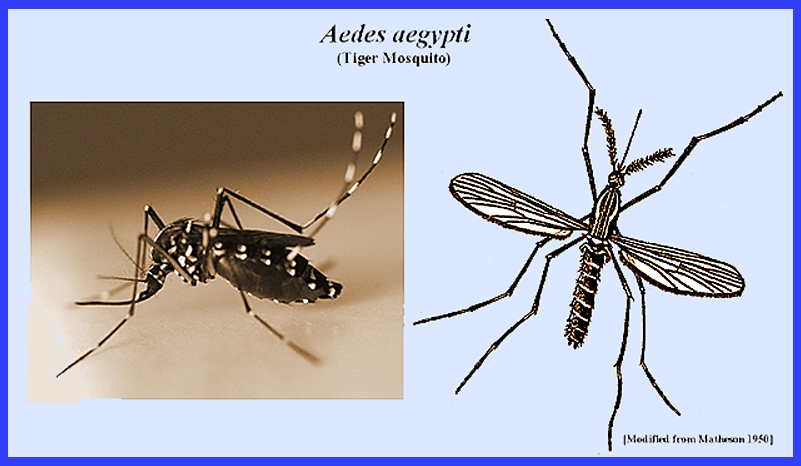File: <yellowfever.htm> <Medical Index> <General Index> Site Description Glossary <Navigate
to Home>
|
YELLOW FEVER DISEASE (Contact) Please
CLICK on
Image & underlined links for details:
Service
(2008) noted that in Africa simians of the genera Colobus, Cercopithecus
and Galago are primary
reservoir hosts, and that the virus circulates among these primates with
mosquito vectors such as Aedes africanus
that breed in tree holes. Matheson
(1950) provides a long list of monkey species that harbor the virus in
nature. Mosquito activity is highest
after sunset in the forest canopy when the hosts have settled down for the
night. The reservoir hosts show only
slight symptoms of the disease, it being rarely fatal. Imported exotic plants such as banana and
pineapple provide a new habitat for the disease to circulate as monkeys leave
the forest canopy to feed on their fruit.
In such places different species of Aedes
that are active during daytime vector the virus. Humans are more apt to be bitten in these forest peripheral
habitats, and subsequently by traveling about they can spread the disease to
other areas and in towns where different mosquitoes will serve as vectors,
such as Aedes aegypti. Service (2008) thus distinguished the sylvatic from
the rural
cycle for the disease. There are
further complications with yellow fever transmission. For example, sometimes the virus may be
circulating among monkey populations but rarely reach humans because the
vector mosquitoes are not strongly attracted to them. The virus may also be transmitted
transovarial among the Aedes
species, which is more common in ticks.
There is also a venereal transmission when virus-infected male
mosquitoes pass the virus to female mosquitoes during mating. In the
Americas the yellow fever cycle is similar but differs in the kind of monkeys
serving as reservoir hosts (Matheson 1950 & Service 2008). The principal vectors are in the
forest-dwelling genus Haemagogus. Humans become affected in the forest
habitat and then carry the virus to surrounding areas where Aedes aegypti becomes the
principal vector species. Matheson
(1950) provides a list of 40 mosquito species that have been found capable of
transmitting the virus (See: Yellow
Fever Vectors). There are also
other blood sucking arthropods that in experiments have been found to
transmit yellow fever virus, including stable flies
and assassin bugs. There is an effective vaccine for yellow
fever, which is important to receive before traveling to areas where the
disease exists. Yellow Fever in Neotropics Cycle = = = = = = = = = = = =
= = = = = = = = Key References: <medvet.ref.htm> <Hexapoda> Barrett, A. D. T. &
S. Higgs. 2007. Yellow fever: a disease that has yet to be
conquered. Ann. Rev. Ent. 52: 209-29. Gratz, N. 2006.
Vector and Rodent-borne Diseases in Europe and North America. Cambridge Univ. Press, England Matheson, R. 1950. Medical Entomology. Comstock Publ. Co, Inc. 610 p. Service, M. 2008.
Medical Entomology For Students.
Cambridge Univ. Press. 289 p Legner, E. F. 1995.
Biological control of Diptera of medical and veterinary
importance. J. Vector Ecology 20(1):
59_120. Legner, E. F. 2000.
Biological control of aquatic Diptera. p. 847_870.
Contributions to a Manual of Palaearctic Diptera, Vol. 1, Sci. Herald,
Budapest. 978 p. Legner, E. F.. 2000. Biological control of aquatic Diptera. p. 847_870. Contributions to a Manual of Palaearctic Diptera, Vol. 1,
Science Herald, Budapest. 978 p. Monath, T. P.
2001. Yellow fever. IN:
Encyclopedia Arthropod Trans. Infections of Man & Domestic.
Animals. CABI, Wallingford. p.
571-77. Mutebi, J. P. & A. D. T. Barrett. 2002. The epidemiology of yellow fever in Africa. Microbes & Infections 4: 1459-68. Reeves, W. C. 1990. Epidemiology and
Control of Mosquito-Borne Arbovirusses in California, 1943-1987. Calif. Mosq. & Vect.
Contr. Assoc. Sacramento. |
